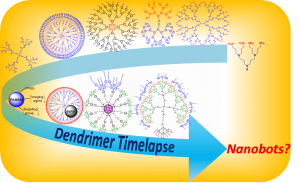 Dendrimers are a special class of polymers with a well-defined branched architecture. The uniqueness of dendrimers comes from the possibility to introduce multiple functionalities at specific sites of the dendritic backbone. Multifunctionality has opened the door for the utilization of the dendrimers in a plethora of applications, such as light-harvesting devices, sensors, catalytic systems, protein mimics, and nanomedicine.
Dendrimers are a special class of polymers with a well-defined branched architecture. The uniqueness of dendrimers comes from the possibility to introduce multiple functionalities at specific sites of the dendritic backbone. Multifunctionality has opened the door for the utilization of the dendrimers in a plethora of applications, such as light-harvesting devices, sensors, catalytic systems, protein mimics, and nanomedicine.
The body of knowledge gathered in the past 35 years about dendrimer chemistry indicates that the unique dendrimer architecture is a valuable tool for the study of electron-transfer processes that have a direct impact in understanding crucial biological processes and in developing new biomimetic systems. Therefore, opportunities remain for the development of dendrimer-based artificial enzymes, sophisticated catalysts, and biosensors.
In the nanomedicine field, multifunctional dendrimers have emerged as competitive candidates for applications in drug delivery, gene delivery, bactericides, MRI contrast agents, fluorescent imaging agents, radiotherapy, photodynamic therapy, and neutron capture therapy.
Thousands of research articles forecasted the exciting applications of dendrimers in nanomedicine; however, the number of dendrimer-based formulations that advance to clinical studies has been somewhat deceiving. Prospect of dendrimers’ use in nanomedicine applications are directly related to their multifunctional well-defined structure. However, most multifunctional dendrimers have been synthesized using a random statistical approach leading to complex mixtures of products that are unlikely to pass regulatory revision. Since dendrimers have been considered “perfect” macromolecules, transforming them in chaotic mixtures before utilizing them in nanomedicine applications contradicts the initial purpose of building such sophisticated macromolecules.
The future of dendrimers’ application to nanomedicine depends on batch-to-batch reproducibility of the final materials’ properties. Therefore, to advance with dendrimer-based materials into clinical trials it is crucial to develop well-defined multifunctional dendrimers with a controlled number and location of drugs, targeting groups, imaging agents, solubilizing agents and/or other relevant motifs. Recent developments on synthetic tools are defying the outdated perception that dendrimers’ synthesis is complex, slow, tedious and cost-prohibitive. Indeed, the very low amount of dendrimers to be used in therapeutic applications will most likely dilute their cost, making their cost/benefit relationship promising for further product development.
The next steps in the dendrimer field will be very challenging and exciting, because it is time to meet the high expectations that were placed on dendrimers.
















